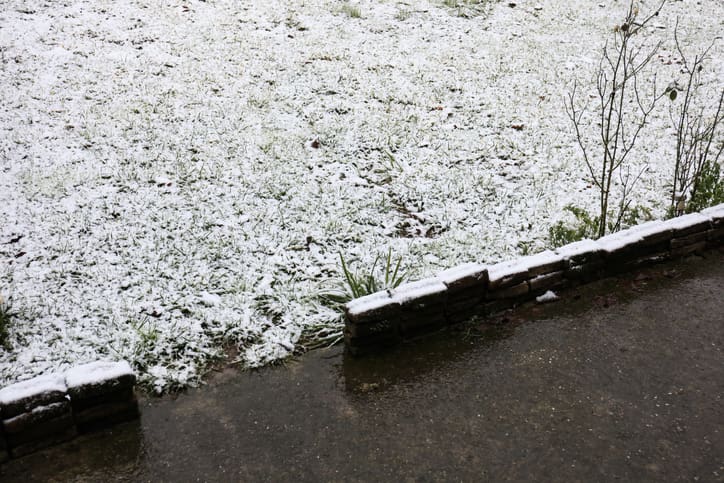
Michigan winters are tough—not just on people but on lawns as well. Freezing temperatures, heavy snowfall, and prolonged periods of dormancy can wreak havoc on grass if not properly cared for. To help you navigate this challenging season, we’ve created a practical checklist of winter lawn care tasks that will protect your lawn through the cold months and set it up for a strong comeback in spring.
Clean Up Your Lawn Before Snow Arrives
Before the first snowfall, it’s essential to give your lawn a thorough cleanup. Debris like leaves, branches, and leftover grass clippings can smother your lawn under the snow, leading to mold, fungal diseases, and dead spots.
- Rake leaves thoroughly: Even a thin layer can cause issues like snow mold.
- Remove twigs and branches: These can damage grass and create breeding grounds for pests.
- Trim the edges: A clean, well-manicured lawn reduces vulnerability to winter damage.
A tidy lawn before winter promotes better airflow and helps grass withstand the freezing temperatures.
Aerate Before the Ground Freezes
Aeration is a key lawn care task that allows nutrients, water, and oxygen to penetrate deep into the soil. The ideal time for this essential task is when soil is moist but not frozen, typically before mid-October in Michigan.
- Why aerate in late fall or early winter?
Compacted soil prevents roots from getting the nutrients they need. Aeration loosens the soil and creates space for roots to access vital resources, even during dormancy. - How to aerate effectively:
Use a core aerator to remove small plugs of soil when soil temperatures are still above 45°F (7°C).
Aeration is especially helpful for lawns in Michigan, where the freeze-thaw cycle can compress soil further during the colder months.

Fertilize with a Winterizing Blend
Applying a winter fertilizer is one of the best ways to prepare your lawn for harsh weather. Winter fertilizers are specially formulated with higher potassium levels, which strengthen roots and improve cold tolerance.
- Timing: Apply the fertilizer before the ground freezes but after your final mow of the season.
- Benefits: A winter fertilizer gives grass the nutrients it needs to survive dormancy and ensures it comes back greener and healthier in spring.
Pro Tip: Look for slow-release formulas to provide sustained nourishment throughout the winter months.
Mow One Last Time (But Not Too Short)
Before winter sets in, give your lawn one final mow to keep grass at an ideal height for the season. Grass that's too long can become matted under snow, increasing the risk of fungal diseases, while grass that's too short can weaken the roots.
- Ideal Height:
Aim for 2 inches for your final winter cut. This slightly shorter height helps prevent snow mold while still protecting the crown of the grass through winter. - Tips for the Final Mow:
- Ensure your mower blade is sharp for a clean cut.
- Collect clippings to avoid creating thatch buildup.
- Continue mowing until grass stops actively growing
A properly trimmed lawn has the best chance of staying healthy through the winter.
Protect Against Winter Pests
Winter pests, such as moles and voles, can cause significant damage to lawns by tunneling under snow or nibbling on grass roots. Here’s how to prevent their activity:
- Reduce Shelter Areas: Keep mulch and shrubbery away from the lawn’s edges, as these areas provide cover for rodents.
- Deter Pests: Apply natural repellents or install barriers to keep pests at bay.
- Watch for Signs: Trails or ridges in the snow can signal tunneling activity—act quickly to address the problem before it worsens.
By taking these precautions, you’ll minimize pest-related damage and avoid springtime surprises.
Handle Snow and Ice with Care
Snow removal might seem straightforward, but improper techniques can harm your lawn. Heavy snow piles or chemical-laden deicers can compact the soil or damage grass.
Smart Snow Management Tips:
- Shovel Thoughtfully: When clearing snow from driveways and paths, avoid piling it onto the lawn. Excess weight can smother the grass and prevent airflow.
- Use Lawn-Friendly Deicers: Opt for products labeled as safe for grass and avoid traditional salt, which can cause chemical burns.
- Limit Lawn Traffic: Frequent walking or shoveling over snow-covered lawns compresses the soil, making recovery more difficult in spring.
Taking a little extra care with snow and ice will preserve your lawn’s health through the season.

Plan for a Strong Spring Comeback
Ensure your yard thrives when warmer weather returns.
- Test the Soil Early: A soil test in late winter provides valuable information about pH and nutrient levels. Use this to guide fertilization and reseeding plans.
- Spot Potential Problem Areas: Look for signs of compaction, bare patches, or areas prone to pooling water after snowmelt. Addressing these issues early will streamline spring maintenance.
Consider scheduling professional lawn services now, so you’re ready to hit the ground running as soon as the snow melts.
The Key to Winter Lawn Survival
Michigan winters may be tough, but with the right preparation, your lawn can handle anything the season throws at it. By tackling tasks like debris cleanup, aeration, and snow management, you’ll protect your grass and ensure it returns stronger than ever in spring.
If you’re looking for expert guidance or services to help with winter lawn care, reach out to Independent Lawn Service at (734) 600-9161. Let us help your lawn survive the cold and thrive in the warmth ahead.
